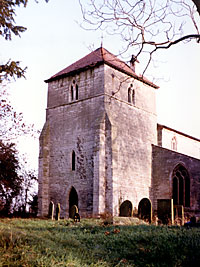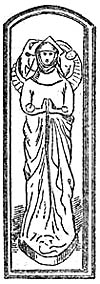ABOUT NOTTINGHAMSHIRE: ITS PLACES AND ITS PEOPLE,
by CORNELIUS BROWN, F.R.S.L., author of "LIVES OF NOTTS. WORTHIES" and
other works.
CHAPTER XXXIX.—A NOTTS. GRETNA GREEN AND ITS STORY.
SECLUDED POSITION OF FLEDBOROUGH—ITS EARLY OWNERS—THE COUNTESS GODIVA—THE NORMAN FAMILY DE LISIEUX—MEMORIALS OF THE BASSETS —JUDGES AND WARRIORS—THE LORDS OF COLSTON—THE BASSETS OF FLEDBOROUGH—WILLS OF SIR RICHARD BASSET AND HIS LADY—CURIOSITIES IN THE CHURCH.—AN EASTER SEPULCHRE—FINE FOLIATED CROSS—A SINGULAR RELIC—MODERN HISTORY—A NOTTS. GRETNA GREEN—RECENT RECTORS—THE PENROSE FAMILY—MARRIAGE OF DR. ARNOLD AT FLEDBOROUGH.

THE CHURCH.
In a previous article on Marnham and other Trent side villages we made a brief reference to Fledborough, which occupies a very secluded site on the banks of the river far away from any great thoroughfare, and as completely shut off from the noise and bustle of this busy world as any place it is possible to find in the county in these days of roads and railways. Since this contribution was written, we have been favoured with to many interesting notes of this out-of-the-way parish —a place intimately associated in early days with the memories of the Bassets, and in modern times with that excellent rector the Rev. John Penrose, and his still more eminent son-in-law Dr. Arnold—that we venture to recur to the subject, and to dwell for a while upon the incidents which give to Fledborough a special claim to notice that cannot be ignored. It will be convenient if we take them as usual in something like chronological order, as it will enable us to draw a picture of village life and activity at its most memorable periods, and to bring upon the stage the great people who have been closely connected with the manor since Saxon times. First of all mention must be made of one who is the heroine of much legendary lore, and of whom and her exploit modern pageants at Coventry have often reminded us. Godiva the famous Countess of the Saxon Earl Leofric of Mercia, is the earliest owner of the village of whom we have any record, and this lady, on pious deedsintent, gave it, with Newark, to the church at Stowe. Her ladyship was well-known by repute in the locality, being the sister of the Sheriff of Lincolnshire, and her benefactions made her popular with church and people. Tennyson has drawn in delightful language a picture of her interview "with that grim earl who ruled in Coventry," and how full of compassion for the town "she took the tax away, and built herself an everlasting name." Fledborough or Flatburch as it was then termed, had four carucats of arable land in her ladyship's time for which she paid the public tax, and after the Conquest it was occupied by one Nigellus, as the tenant of the Bishop of Lincoln. The quantity of land under cultivation had increased a little, and there was a considerable extent available of pasture wood. That the manor was prospering and important is shown by the fact that there were on it, as proved by the entry in Doomsday Survey, fifteen villeins and five sochmen—making almost as large a population as it has to-day—and that in addition to tenants and labourers, it possessed a priest, a church, and a mill. Nigellus bore the surname of the village, and the tenancy continued with his descendants for a century or more. Then there came upon the scene members of the Norman family, De Lisieux, who held the manor of the Bishop as chief Lord, and it was during their residence here, that the great work of building a new church was commenced.

St Gregory, Fledborough. The lower stage of the tower is Norman; the upper part dates from the 13th century (photo: Andrew Nicholson, 1982).
The main portion of the sacred edifice, which stands in the centre of the parish, a short distance from the Trent, belongs to the first half of the 14th century, though the tower, which is by far the oldest portion of the church, may be attributed to a much earlier period. For a small village, the building was designed on a scale of unusual liberality. There was a fine nave with clerestory, and north and south aisles, and a spacious chancel extending to the length of 44 feet. There was a chancel aisle divided by an arch from the main structure, and at the north-east end of the chancel a Lady chapel. Herein worshipped, in a building worthy to take rank with the best in the county, the knightly family De Lisieux, one of whom, Sir John de Lisieux, founded a chauntry, temp 17 Edward III., and while the King was in Normandy, obtained a licence dated Nov. 6th, to appropriate the church to certain chaplains for that purpose. Sir John had a son James who died without male issue, and the Estate passed from Lisieux to a still more famous family—that of Basset, some of whom had occupied positions of great influence and power. The Bassets, like the men they succeeded at Fledborough, were of Norman birth, and had been enriched by Royal grants until they were the owners of considerable property in the Midlands. Ralph Basset was chief justice in the reign of Henry I., and was selected to carry into execution the severe laws enacted by Henry for the suppression of rapine and robbery. He is mentioned in 1124 as holding a court at Huncote, in Leicestershire, for the trial of offenders, where he caused no less than forty-four men convicted of robbery to be hanged. He left several sons, some of whom were justiciars, and from their issue various baronies sprang. Amongst other property which he possessed was the Manor of Colston in this county, some part of which he gave for the maintenance ot a monk in the Abbey of Eysham. Before his death he assumed the monastic garb himself, and after making liberal benefactions to the church died at Northampton. Richard Basset succeeded his father as chief justice, and married Matilda, daughter of Geoffrey Ridel, another judge of great wealth and dignity. These worthies gave the church of Colston to the Church of St. John the Baptist, at Laund, in Leicestershire, which they had founded for King William and for the souls of their famous ancestors. After Richard Basset came a further succession of eminent lawyers, Thomas William, Simon, Allen, and others, Simon being one of the justices itinerant who fixed the tallage for the counties of Nottingham and Derby in 1197-8. From 1120 to 1249 there was always a Basset on the judicial Bench, while other members of the family in subsequent years rendered active service on the field of battle. It would occupy too much space to narrate the exploits of Ralph Basset, Lord of Drayton, the owner of Colston, and of his successors. In the barony, nor can we do more than mention incidentally the Bassets, Lords of Sapcoate, who also had property in this county. We must confine ourselves to those of the family holding less distinguished positions who were connected with Fledborough, and of these the first to notice is William Basset, who is styled Lord of "Fledburgh," temp 6 Richard II.. and on whose seals were the same coat of arms as that borne by the Bassets of Drayton:—Or. three piles gu. a canton erm. From William the manor passed to his descendants in direct line for several centuries, and there is nothing to say of them except that they intermarried with other local families, and were among the leading gentry resident in the county. In the time of Hen. VIII. the property was owned by Sir Richard Basset who had married Elizabeth, daughter of John Dunham. We have been favoured with copies of their wills, and as they contain a good deal of interesting local information, and some details of the dress and armour of Tudor days, we hope to find room for them in another issue with a fw explanatory notes interwoven in the text. The worthy Knight and his lady were succeeded by their eldest son John, who died 20th May, 36 Henry VIII, leaving Edward, his son and heir, about twelve years old. Edward grew to man's estate, and the property passed at his death to his eldest son John, who sold Fledborough to the feoffees of the Earl of Shrewsbury. Subsequently the manor became part of the possessions of the Earl of Kingston.
 |
 |
| EFFIGY OF A WOMAN. | COFFIN LID WITH FOLIATED CROSS. |
Having thus traced the devolution of the property through a long line of ancient owners, it will be interesting to see what there is remaining to remind us of those Knights and Esquires who made this little village their home in days long ago. Naturally, we turn to the church, the sacred link that binds the old and the new together, and here there is a great deal to notice that is worthy of closest attention. The sacred edifice is still of fair proportions, but it is much smaller than in the days of the Knights of Norman descent, who assisted in its erection. In 1764, the church had become sadly in need of repair, and in response to a petition from the inhabitants the Duke of Kingston, and the Archbishop of York, co-operated with the rector to build up out of the-crumbling walls a neat and snug building. The chancel aisle and the south aisle of the nave were walled up, and the chancel reduced to about a third of its original size. But in the altered edifice many of the antiquities remained, aud continue to this day. There is a mutilated effigy of stone supposed to represent one of the Bassets, and a stone-coffin lid bearing an unusually fine foliated cross. There was a college of chantry priests, and the coffin to which the lid was attached would probably contain the remains of one of the priors. There are several other coffin lids of stone marked with the Latin cross, and more or less elaborate in pattern. When the heating flues were introduced it was at first proposed to run one up the south aisle corresponding to that in the north, but it was found that the stone coffins of the priests lined the whole, or nearly the whole, of the aisle, being placed side by side. The portion of the north aisle between the pillars of the first bay has evidently been a chantry chapel, and is believed to have been connected with Woodcotes, a hamlet to Fledborough. The seats in the north aisle chapel have always been appropriated to Woodcotes farmers. The screens have disappeared, but the altar would be under the east window of the aisle; the credence, or aumbry, is extant in the north wall. Over the altar (on the filled-up light, a noticeable feature) was a bracket with crocketed canopy, and on the bracket there must have been an image—probably the Virgin and child. To right and left of this are other brackets. In the two remaining lights is most beautiful ancient glass of about 1300 to 1350—coeval in fact with the main building. It comprises the figure of a knight in armour of a very early period (and of early drawing— void of perspective), some early saints with legends and much tabarnacle work, giving fragments of domestic architecture. The groundwork is all stencilled in grisaille, and is of a beautiful pale green. The glass was, in part at least, collected from various parts of the church, and put together by Canon Nevile, the predecessor of the present rector. The glass in another window of the north wall is a century later in date. At the end of the south aisle, reared against the outer wall, is the full length figure of a woman, sculptured in stone and holding a heart in her hands. This is said to have been found in a vault. It has certainly been recumbent, and must have come from the chantry or Lady Chapel. The figure is beautifully draped but the salient feature is the wimple, a vestment which was much in vogue from 1300 to 1350. It was a covering for the neck, and was used more or less from the thirteenth to the fifteenth centuries. "Wimples dyed in saffron" are mentioned among mercers' stores in the thirteenth century, and the mother of Henry VII. is represented in one which coyers the neck and reaches halfway to the elbow. Chaucer, in the "Romaunt of the Rose," points out the distinction between that and the veil.
Wering a vaile insted of wimple,
As nonnes don in ther abbey.
The figure is one of much interest and was engraved in the Gentleman's Magazine some 80 or 90 years ago. A monumental recess in the north aisle bears an inscription to Hugh de Normanton, formerly canon of Lincoln and rector of the church, but some of the letters are illegible. Of an Easter sepulchre there remain nearly perfect—(1) Panel in three divisions, under ogees, with blank shields between, representing the Roman watch, asleep on their arms. (2) Upper portion of panel representing the Resurrection—the figures of Our Lord and two angels, down to the waist only and much mutilated. (3) A fragment of canopy corresponding with the above. (4) Fragment of canopy on a larger scale, which may have been part of a large canopy crowning the whole structure. From an expression in the will of Sir R. Bassett directing that; he be buried at the north end of the high altar "where the Easter Sepulchre is wont to be placed on Good Friday," it would almost seem as if this at Fledborough may have been movable. If so it may have taken the form of an ark; the two extant panels forming the sides, and the canopied arches part of the ends. All the windows of the church appear to have been filled with stained glass, as shown by the tabernacle work which exists in every window that has not been superseded by a more recent one. The coats of arms in the cuspings of the window lights are those of De Lisieux, Basset, Stanhope, Molyneux, and other families who have been connected with the manor. There is one other relic, though not in the church, to which reference must be made. Mr. Billyard has in his possession a small silver heart-shaped reliquary, bearing on it the implements of the Passion scourge, nails, &c., and containing a dark substance, which may be charred bone or wood, but which, says our informant, refuses to yield up its secret to the ordinary microscope.
